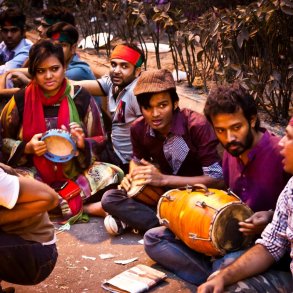
While describing Shahbag Square movement, frequent references are being made to Tahrir Square, the site of recent anti -autocratic movement in Egypt. However, although there are more similarities, Shahbag has not yet been discussed in reference to the famous Tiananmen Square movement of 1989 in China. The reason of missing Tiananmen reference may be two pronged. One, in ultra-short memory span of the minds of the analysts of Shahbag Square movement, an event of 1989 is not much distinct now.

Second reason could be the discomfort of some of our leftists, the major intellectual backers of Shahbag square movement, in invoking Tiananmen Square, which, in Chinese Communist Party’s eye, was nothing but a western sponsored bourgeois capitalist counter-revolution against communism.
Tiananmen Square started on a relatively small issue. Students of Beijing University and surrounding areas gathered to mourn the death of reformist and liberal leader Hu Yaobang, who was recently removed from party secretary general position by the communist conservatives. This gathering for eulogy rapidly gained momentum. There was unprecedented outpouring of support from students from all over China, urban population of Beijing and the intellectuals. The 24 hours sit in of the students continued for 7 weeks and within few weeks, Tiananmen Square daily youth gathering reached over a million. Initial mourning gathering quickly turned into a mass sit-in hunger strike with some clearly articulated demands. The demands included exoneration of Hu Yaobang, press freedom, economic liberalization and more democracy. Initially Tiananmen Square enjoyed backing from the government as the new Party Secretary General Zhao Ziyang, also a moderate, was soft with the student’s cause. Students at Tiananmen Square also enjoyed overwhelming support of the Beijing residents, artists and intellectuals.
As the sit-in and mass hunger strike dragged on through 5th and 6th week, it started creating significant rift in Chines Communist party top tier leadership. Emboldened conservatives, in favor of taking a hardline against the protesters in Tiananmen Square, sidelined moderate reformist voices including party secretary general Zhao Ziyang. And at the same time, serious leadership crisis started developing among the protesting students too. With no clear leader, students got fragmented into multiple groups. Sustained overcrowding and dangerous hygiene issues added to the stress. Without a leader in control, as students continued their push without a clear exit strategy, a major military operation was launched on June 4 1989. With this operation, the hardliner led government reclaimed Tiananmen. The estimated number of death during this military operation range between a few hundreds to several thousands. In addition, it put a stop to the political reform and liberalization process of China.
The 18 day protest in Tahrir Square of Cairo, Egypt aimed at getting rid of the autocratic ruler Hosni Mubarak. The non-stop gathering of young Egyptians, mostly students, urban educated citizens, artists and intellectuals reached several hundred thousand strong at its peak. This protest, unlike Tiananmen Square protest, faced government’s ire from the beginning. And this protest was also marred by regular clashes with the loyalists of the autocratic ruler Mr. Hosni Mubarak. While the demand of the Tahrir Square movement was removal of autocracy and restoration of democracy, press freedom –Tahrir Square resulted in and ended with a hostile take-over of the government by Egyptian military. An election in the aftermath brought the Muslim Brotherhood to power, which was by no means a suitable alternative for the Tahrir protesters.
So how Shahbag compares with Tiananmen or Tahrir Square?
There can be clearly identifiable differences in terms of demands as well as the nature of the protests when it comes to the relationship with the establishment. Although Tiananmen Square initially enjoyed the support of the moderate fraction of the Chinese Communist Party, it faced the most brutal government repression at the end. The legendary photo a protester standing in front of a tank became the symbol of defiance and protest everywhere in the world. Tahrir Square movement constantly faced strong resistance from the government forces. Tahrir Square became a major part of the Arab Spring of 2011 where the youth stood up against the decade old autocratic institutes and rulers.
On the other hand, the Shahbag Square movement, although started with an instant rejection of the sentencing of a convicted war criminal and suspicion of an unholy collusion between the Awami League and Jamaat, quickly saw full solidarity of the government and the entire state and corporate establishment. By day two, Shahbag movement saw itself standing shoulder to shoulder with the government with similar demands. The prime Minister and the government MPs expressed all sort of solidarity with Shahbag Square protesters. Unlike Tahrir Square or the last days of Tiananmen Square, until now, the sit-in is Shahbag has enjoyed full protection of government security agencies.
Although Shahbag has enjoyed government backing and protection, there is absolute no reason to believe that the mass gathering in Shahbag consists of government supporters only. People from all walks of life, all cultural spheres and from across the great political divide of the country have joined the mostly exuberant occasion in Shahbag. And in an unprecedented way, Shahbag earned the support and the endorsement of all major feuding political forces. Shahbag movement may be the first event in decades to enjoy some form of public support of both the Awami League and BNP.
While the evolved demands of Tiananmen or Tahrir Square addressed much broader issues like restoration of democracy, press freedom, economic liberalization or release of political prisoners, the demands of Shahbag movement has remained static at some narrow focused demands of hanging death of some alleged war criminals, banning of a rightist political party and closure of a Bank alleged to be funding the activities of that party. And the lack of evolution of demands keeps many of the intellectual supporters of Shahbag movement ambivalent.
It seems the Shahbag movement has failed to evolve their demands into a broader context. This failure to eloquently explain the demands of hanging the defendants in the backdrop of an ongoing judicial process, banning of a political party in a democratic state and closure of an economically important publicly traded financial house in an open market economy without proof or investigation may cause the of Shahbag Square movement not achieve major revolutionary changes.
When the achievements of Tiananmen and Tahrir Square are analyzed, it is clear that both the movements ended in failures. However in the longer run, although some analyst believe that it made China a more military surveillance state, many feel that Tiananmen Square reshaped and prepared China for the 21st Century. Similarly it a norm to protest government wrongdoings in Egypt, which remained silently under an autocracy for decades. Tiananmen Square shaped up the ruling communist party badly and radically changed how the party high ups operated and made the leadership very aware of the fact that their actions can be challenged and they may have to be accountable to some extent. Tahrir Square taught otherwise suppressed Egyptians how to stand up and protest.
It remains to be seen how effectively Shahbag square movement can replicate itself under a hostile government or environment. Yet however narrow their demands there may be, Shahbag Square movement also heralds a new horizon in Bangladesh’s political landscape. And this is how Shahbag gives us hope. Shahbag teaches us to stand up without being called to stand up by a political force. Shahbag also showed Bangladesh to protest peacefully together across political spectrum. Shahbag shows us that People from all walks of life can organize without patronization of one or the other political party and major concessions from the political stakeholders can be gained by simply peaceful sit in protest.
Source: Alal o Dulal









